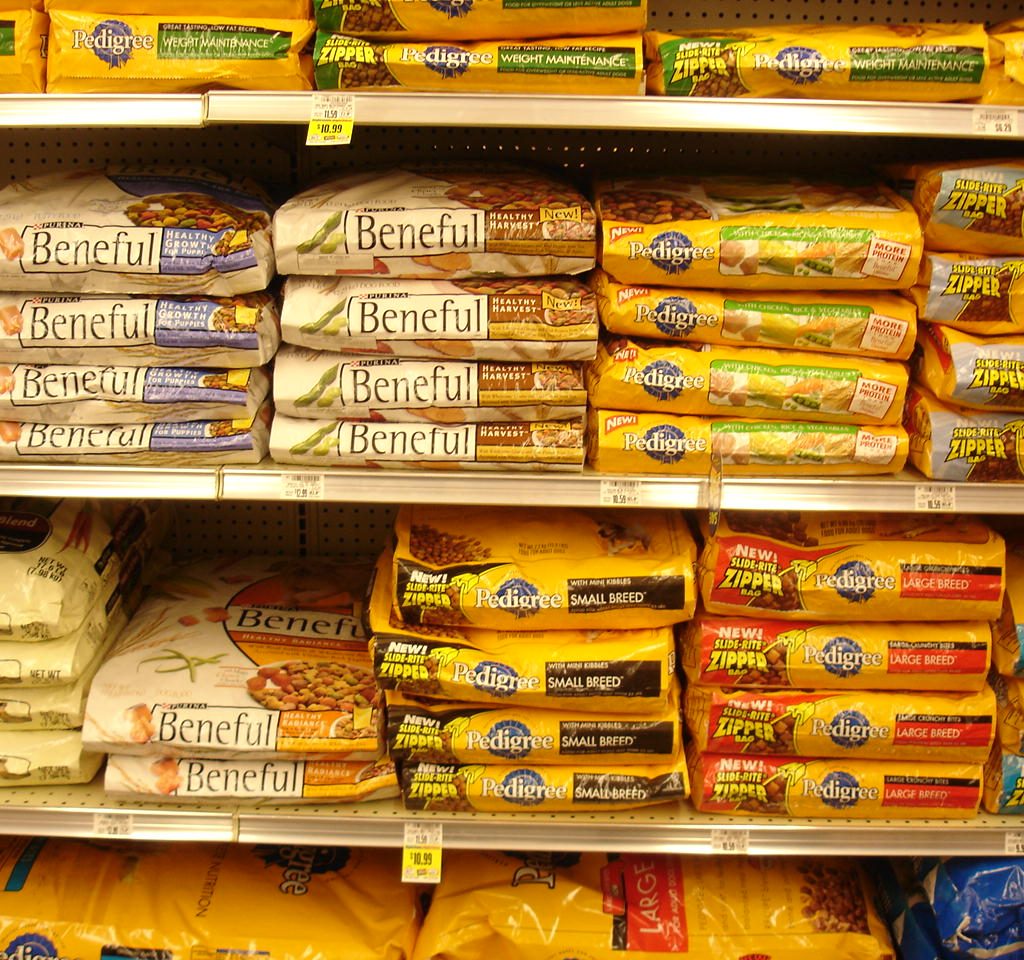Important Information About Dog Food Labels
We all want what’s best for our Pug dog, and we will go to great lengths to get it, including studying dog food labels.
Let’s face it. Pugs will eat anything. Cheap food, high-quality food, twigs, pine cones, feathers, toilet paper, or anything they can get their paws on. So, we must be the responsible ones and find out what’s best for them to ingest.
Obviously, they’re not going to do it!
There is a lot of information on a dog food label about ingredients and nutritional facts. It seems like you need a Ph.D. in Nutrition and Science when it comes to reading dog food labels.
Dog food labels are complicated. One bag says natural, another says science, a picture of a fish, grain-free, wolves, bison, and one with carrots.
Oohhh…. What about a picture of a bear? Pugs, bears? I don’t get the connection.
Words like “natural,” “gourmet,” or “farm-fresh” have no legal definitions. I wish the chicken my dog ate were happily running around in the clean open space before her fateful day! Probably not.
Fresh? Probably came in on the truck a few months ago.
Natural? My Pug’s poop is “natural,” but I don’t want that in her dog food. The waste from the slaughter room floor is natural too. You get the idea.
Organic?
People are turning to organic food and for good reason. It’s important to understand what that means on a dog food label.
Organic vegetables, grains, and fruits are grown without pesticides, synthetic fertilizers, or chemicals.
Organic livestock is fed a healthy diet. They are not given growth hormones or antibiotics. They also eat only organic feed.
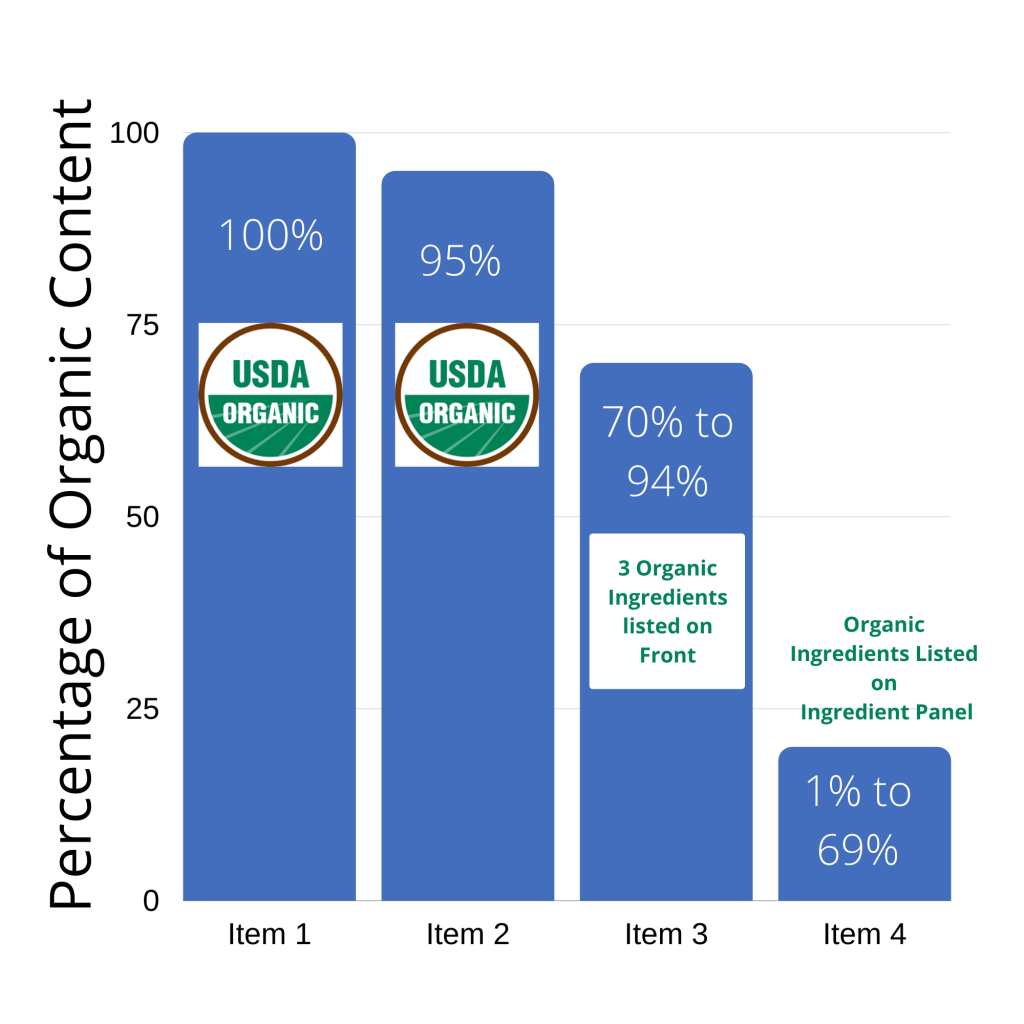
On a dog food label, 100% organic means the manufacturer may display the seal. All the contents are 100% organic.
If it shows the USDA organic seal, at least 95% of the content is organic by weight.
If you see a dog food label that says “made with organic ingredients,” it means at least 70% of the content is organic. It can list up to three of those ingredients on the front of the package, but it cannot display the seal.
If less than 70% of the content is organic, the package can list the organic ingredients on information panel on the dog food label. But it cannot use the word organic, and it cannot display the seal.
Dog Food Label Overview
The Association of American Feed Control Officials (AAFCO) of all dog food. They set the standards for the pet food industry.
If a buy your pug dog food with the AAFCO statement, does it mean it’s high quality? No. It merely means that the product meets minimum nutritional requirements. You still need to look at the ingredients.
Somewhere on your dog food label you will probably see AAFCO.
Product Name
According to the AAFCO, the name must be truthful. If it says “Chicken for Dogs,” it must contain 95% chicken (or beef, lamb, or other protein sources).
Some dog food labels will write “95%” beef, chicken, lamb, etc. on their label.
If it says “Lamb and Rice,” it must be 95% lamb.
Dog food that says “dinner,” “platter,” “formula,” “recipe,” “entree” or “nuggets,” must contain at least 25% of the named ingredient. For example, “Chicken Dinner for Dogs” only needs to be 25% chicken.
If a dog food says “With Beef,” it means at least 3% beef.
If it says “Chicken Flavor” dog food, there are no requirements. The dog food will contain very little chicken, or as my vet says, “They waived a dead chicken over the food!”
Gravy, sauce, or stew dog food can have up to 87.5% moisture.
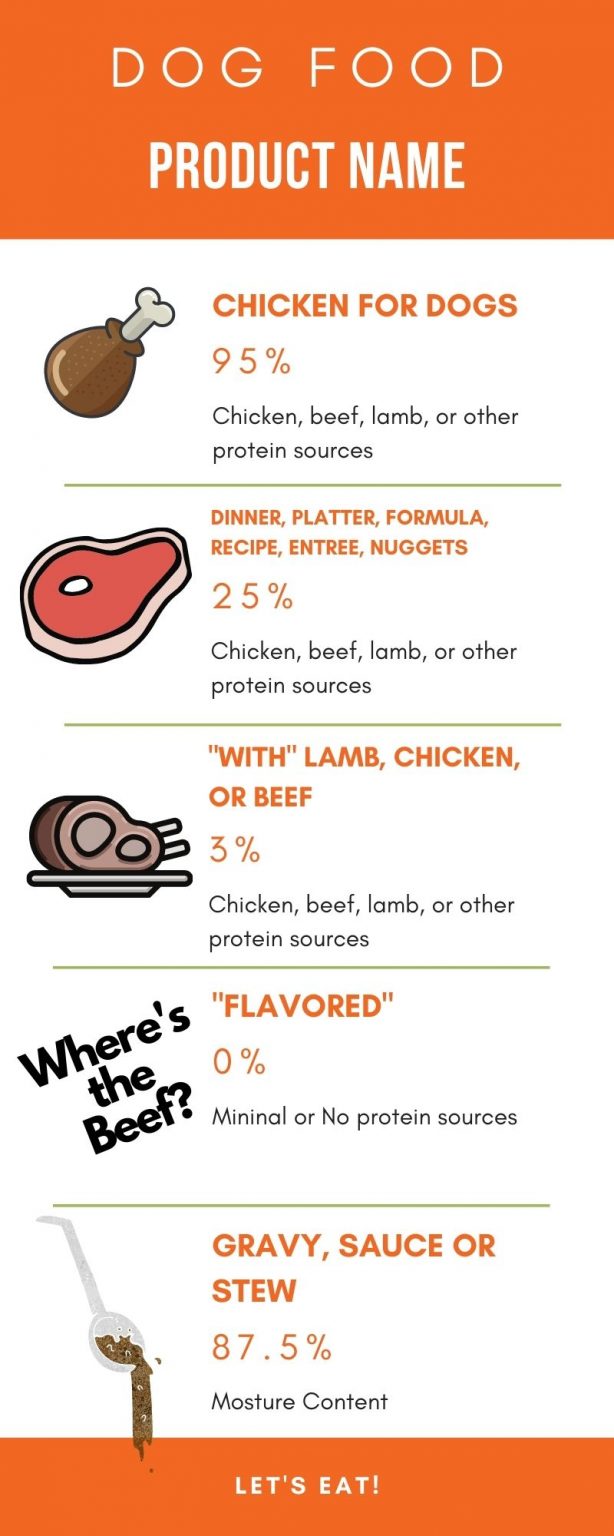
Dog Food Label Ingredients
As you may already know, you want your first ingredient to be protein.
Chicken, beef, lamb.
Check!
Chicken or beef meal is often your second ingredient on the dog food label.
What Can Be Included in Meal?
- Chicken
- Beef
- Skin
- Bones
- Heart
- Esophagus
- Tongue
- Diaphragm
Grind it up and dry it until there is 10% moisture. It’s concentrated protein powder.
Pros: It has more protein than just meat. The moisture content is only 10%, and the protein content is 65%. Regular chicken is 70% water and only has 18% protein content.
More protein. Must be better?
How bad can ground up bones and organs be? Let’s look at the cons.
Cons: The chicken and beef are cooked in large vats. Meat gets rid of infectious agents through this process. So “4D” animals are also included in the meal.
4D? Dead, dying, diseased, and disabled.
It’s unfit for human consumption. It makes you wonder. I can’t eat it, how can it be okay for my dog? You decide.
If it was listed specifically on the dog food label, what the meal contained, many people would not purchase it.
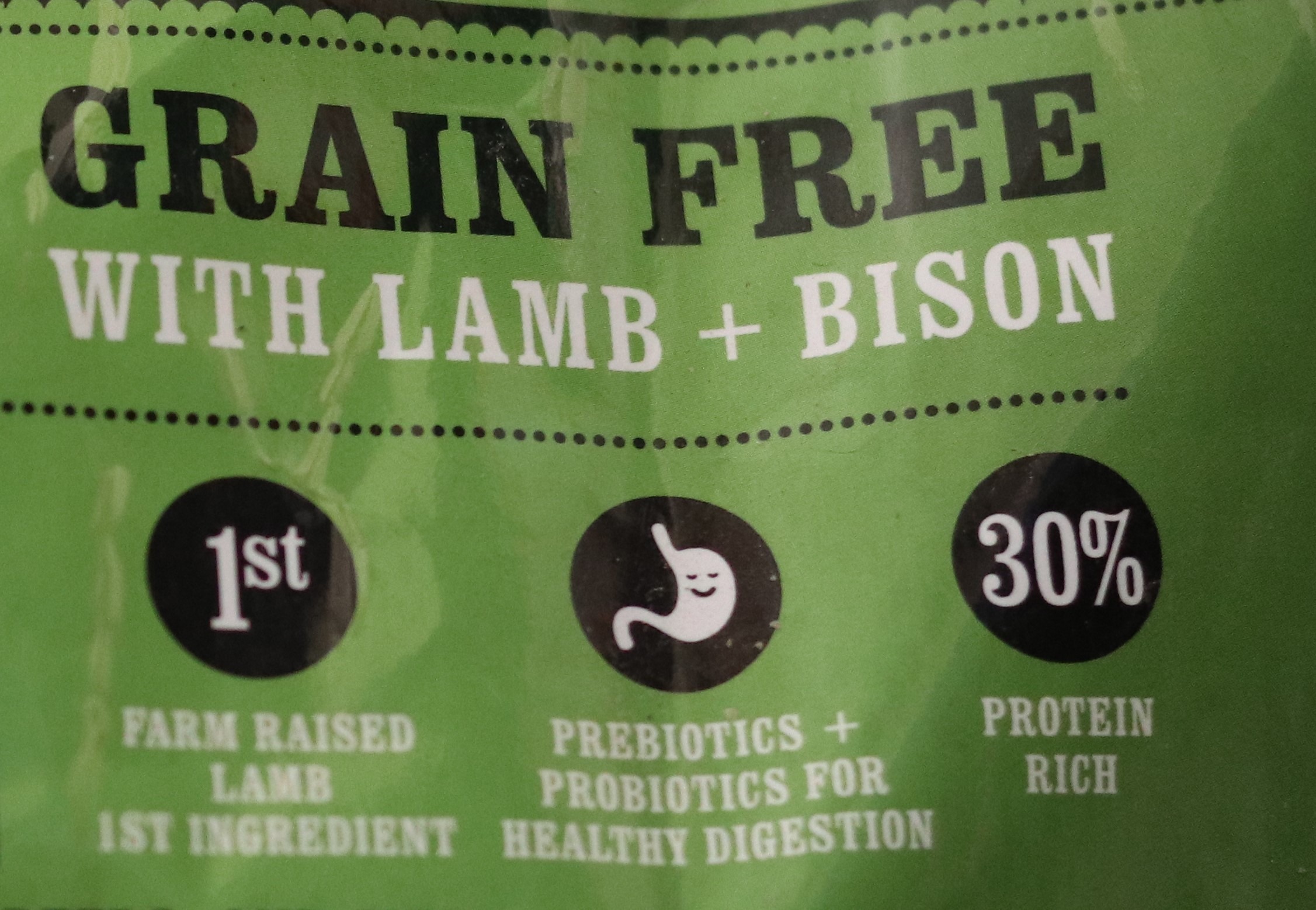
What about chicken or beef by-products?
The answer is simple. No.
By-products are cheap. Protein levels are kept high, but the quality is not. By-products are slaughterhouse waste. If it says “by-products” on your dog food label, here is what is contained in by-products:
- Backs
- Feet
- Livers
- Lungs
- Heads
- Brains
- Spleen
- Frames
- Kidneys
- Stomachs
- Intestines
- Undeveloped eggs
- Blood
Read All the Ingredients on the Dog Food Label
The top 5 ingredients listed will be present in the highest quantity. High-quality dog food will have animal protein listed as the first ingredient on the dog food label.
Do dogs need carbohydrates? For survival, no. For energy and fiber, yes. Carbohydrates can increase energy in the body’s cells, including the brain.
Fiber can help with weight management, digestion, and control blood glucose levels.
So why do so many dog foods advertise “grain-free?” We often think of grains when we think of carbs, but there are many other sources to get carbs.
Dogs don’t need whole-grains, but most vets agree that 10% grain in your dog’s food is acceptable. Avoid carbs like corn and wheat. They are just cheap fillers. Especially avoid food if corn is written on the dog food label.
I recently saw a fairly expensive brand on the shelf with the first ingredient as corn! Put your reading glasses on and read the fine print on those dog food labels.
Carbs also include peas, lentils, beans, chickpeas, potato, sweet potato, and tapioca. These are often found on dog food labels.
Peas and potatoes are carbs that also provide protein. But they are less valuable for your Pug than animal-based protein. These products are sometimes used to boost protein without having to add more meat.
Keep a lookout for high-quality fats like chicken fat, salmon oil, and other fish oils. Dogs need these. Plant-based oils like flaxseed oil may also help. Yet, animal-based ingredients are always best.
The next 15 to 20 ingredients on the dog food label are in small quantities. They probably don’t make a noticeable difference.
Some expensive dog food advertises probiotics or superfoods. These are in small amounts and probably won’t benefit your Pug.
You’d be better off giving your Pug dog chemical-free yogurt with active cultures. Or just give her some blueberries. She’ll love them!
The Chemicals on the Dog Food Label
Now I’m going to contradict myself.
I know I said the ingredients at the bottom of the list on a dog food label don’t matter much. But I’m not willing to take any chances with chemicals.
The FDA must approve all the preservatives, artificial colors, and stabilizers. I avoid chemicals as much as I can in my diet. I want the same for my Pug.
Preservatives are put in dog food to stop fats from turning rancid and keep dog food fresh for about a year. These are synthetic preservatives BHA (butylated hydroxyanisole), BHT (butylated hydroxytoluene), or ethoxyquin.
Some people say they’re not safe even though the FDA disagrees. The FDA says they are safe for the “level used in dog food.”
There were complaints in 1990 about Ethoxyquin, a preservative. It resulted skin allergies, reproductive problems, cancer, and organ failure in some dogs. In 1997, the FDA cut the maximum allowed in half. Tests showed possible liver damage in dogs fed high levels of the preservative.
Call me crazy, but poison is poison. Cut the dosage and half, and it will just take you longer to get sick!
Be aware of you see Ethoxyquin on the dog food label.
Vitamin C, vitamin E and some plant extracts are also preservatives. Some dog food manufacturers have switched to these. They keep food fresh, but for a shorter period.
Pug dog food staying on the shelf for a year? Not likely with our chowhounds. LOL! But check the dog food label to be sure it’s still good when you buy it.
Guaranteed Analysis
What about the guaranteed analysis? That sounds important! You will always see the words “Guaranteed Analysis” on a dog food label.
It’s reports for the minimum percentages of crude protein and crude fat. Guaranteed analysis also reports the maximum percentages of crude fiber and moisture.
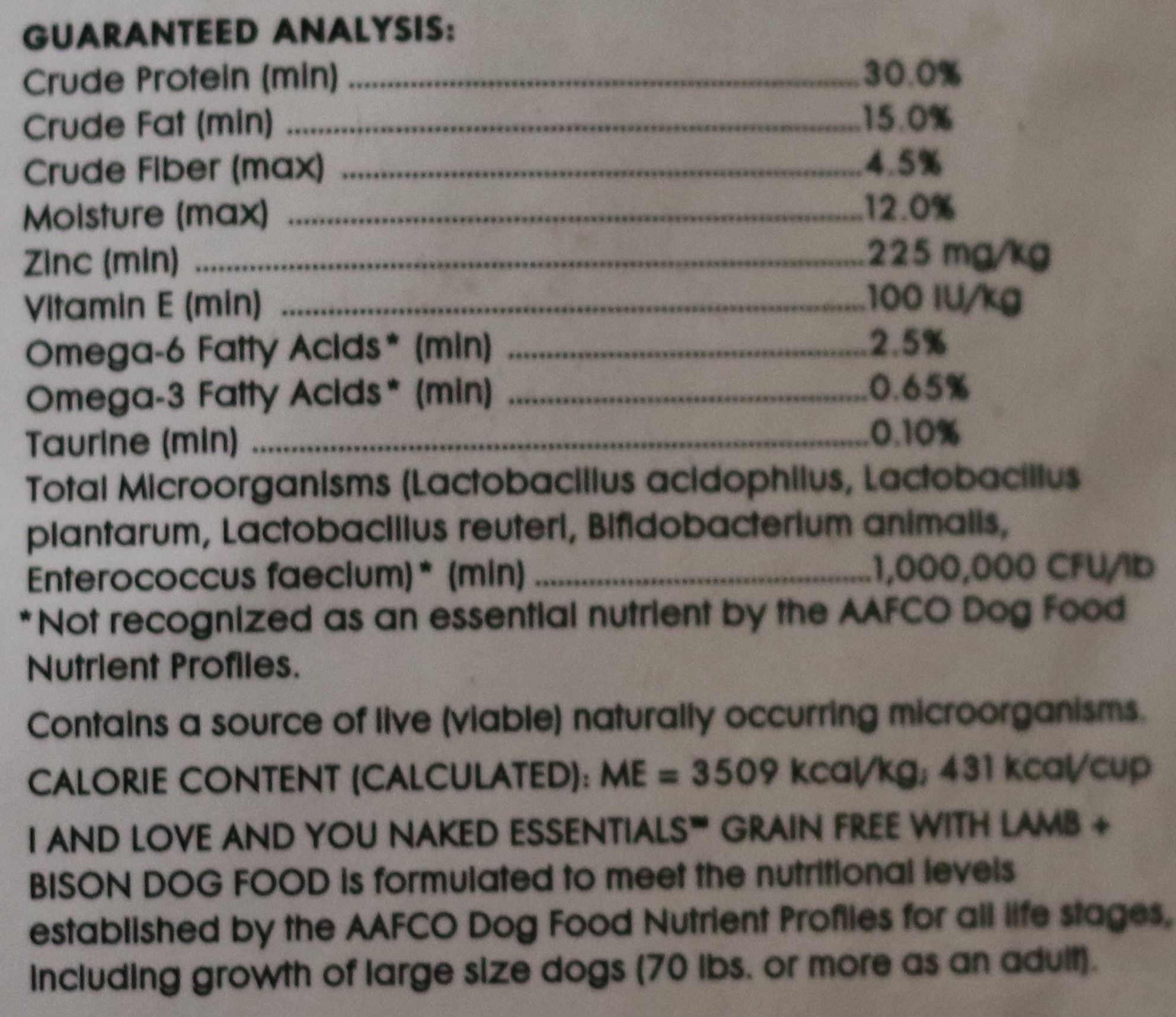
Crude protein is determined by a method of testing. It does not tell you how much animal meat is your dog’s food.
It doesn’t determine the nutrition or how digestible it is.
Crude protein could include the following:
Chicken, beef or other kinds of animal meat
- Beef meal or chicken meal
- Soy
- Rice
- Grains
- Garbanzo Beans
- Carcasses
Pet foods have different moisture contents. So the guaranteed analysis can be a little misleading. To understand how much protein fat or fiber, there is in your Pug dog food, we have to do a little math.
Look at the protein in dry food as written on the dog food label. Let’s say your dog food says there are 20% crude protein and 10% moisture.
These numbers tell you that 90% of your dog food is dry. To find out how much protein there really is, you need to divide 20 by 90. That’s 22%.
Let’s say you bought canned food.
The dog food label says 5% protein and 80% moisture. Then 5% divided by 20% (dry matter), then we get 25% protein.
In this canned dog food example it looks like there is only 5% protein. Once the water is taken out, the protein percentage is higher.
Got it?
Before you run off to the store, ask yourself, “how much protein does my pug dog need?”
Protein Needed for Dogs
She’s not a wolf, even though she may think she is sometimes.
Our Pugs and other canines need the following amount of protein:
- Puppies 22-32%
- Adult Dog 15-30%
- Performance Dog 22-32%
- Racing Dog 28-34%
- Lactating Dog 25-35%
What does that look like in their bowl?
Your dog needs about 1 gram of protein per pound of Pug. My Pug weighs 14 lbs. so she needs 14 grams of protein per day.
There are about 28 grams in an ounce. An ounce looks like two tablespoons. She needs half of that (1 tablespoon) for 14 grams of protein.
That’s it? Yes.
To confuse you even more, remember that a tablespoon of meat is generally 80% moisture. Just believe me when I say that works out to about five tablespoons of meat each day or 2 ½ per meal.
Now you can say, “That’s it”?
Yes. I do believe that high protein is overrated and a marketing gimmick. The important thing about our pug dog’s health and protein is the amino acids.
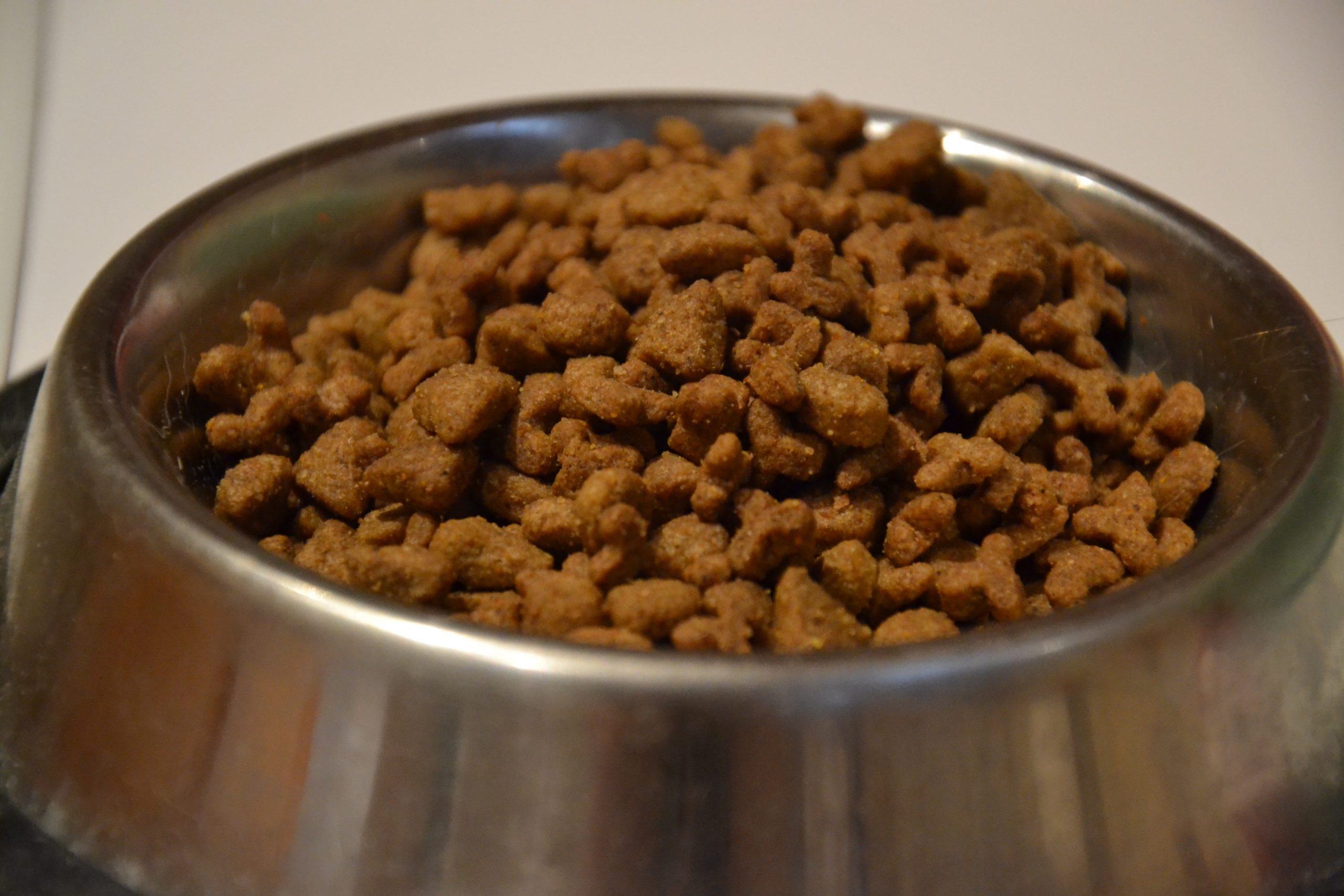
Nutritional Adequacy Statement
The Nutritional Adequacy Statement guarantees that the dog food meets specific requirements. This depends on your Pug’s stage of life.
According to the AAFCO, there are two stages: Adult and Growth/Reproduction.
Adult maintenance dog food is for adult dogs with normal activity levels.
Since our Pug dogs aren’t out doing hours of agility training, adult maintenance is probably fine.
Growth & Reproduction dog food is for puppies and pregnant or lactating female dogs.
There is also “All Life Stages,” and you won’t see it very often. It follows strict guidelines for feeding it to adults and puppies.
Complete and Balanced
Is your pug dog food “complete and balanced?”
“Compete and balanced” means the AAFCO means the dog food has the correct nutrients.
What are the AAFCO guidelines?
Adult Maintenance Dog Food and Senior Dog Food must contain a minimum of 18% protein, 5% fat. These dog foods have no maximum for protein or fat.
Puppies need more protein and fat when they are growing. Therefore, puppy dog food must contain a minimum of 22% protein, 8% fat. No maximum for protein or fat.
Your dog food label could say “complete and balanced” with 18% protein, and the first ingredient is corn!
Another dog food label could say 25% protein, and the first ingredient is boneless chicken.
Because they’re both “complete and balanced,” does it mean they are both good for your Pug dog? The primary corn dog food can boost up their protein with meat and bone meal. It seems that meat and bone meal in the dog food industry has a worse reputation than chicken meal and beef meal.
What does all “complete and balanced” mean to you and your Pug? Not much. You want your Pug dog food to be “complete and balanced” to meet the minimum requirement, but don’t pay extra for it. Your dog food could still have terrible ingredients such as corn.
Not only do we have to read the dog food labels, but we have to study them.
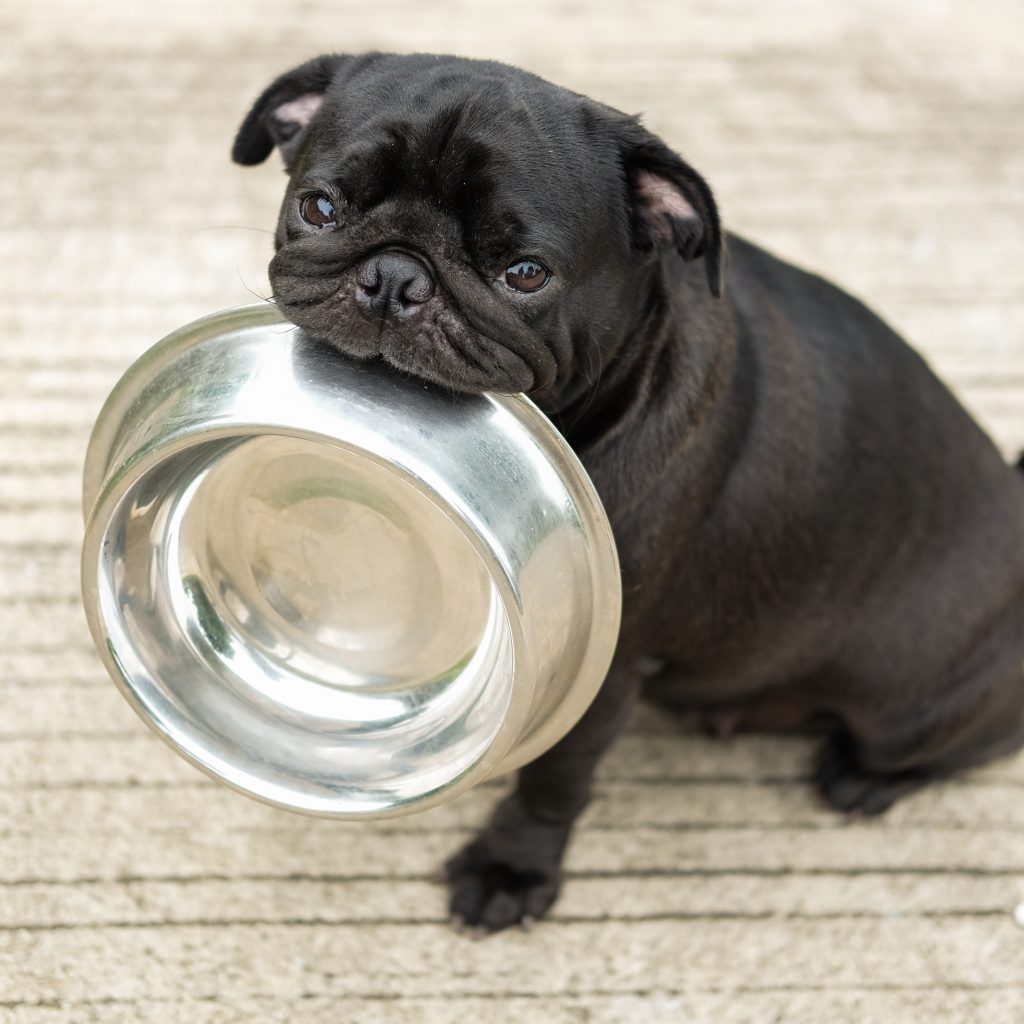
Feeding Directions
The dog food label will print feeding directions on it. It will explain how much to feed your dog each day. Dog food labels are required in the dog food industry.
The directions are guidelines for your Pug dog. They are usually spelled out by body weight. Start with what the dog food label says and then increase or decrease based on your Pug’s needs.
I have read that it is okay to free feed your puppy until three months old. I don’t think the person who wrote this has ever had a Pug. And just like us, it’s easy to put a pound on, but difficult to take it off.
An extra pound can mean breathing and health problems.
Obesity in Pugs can lead to muscle and joint problems, diabetes, and heart disease.
As a place to start, follow the information in this graphic.
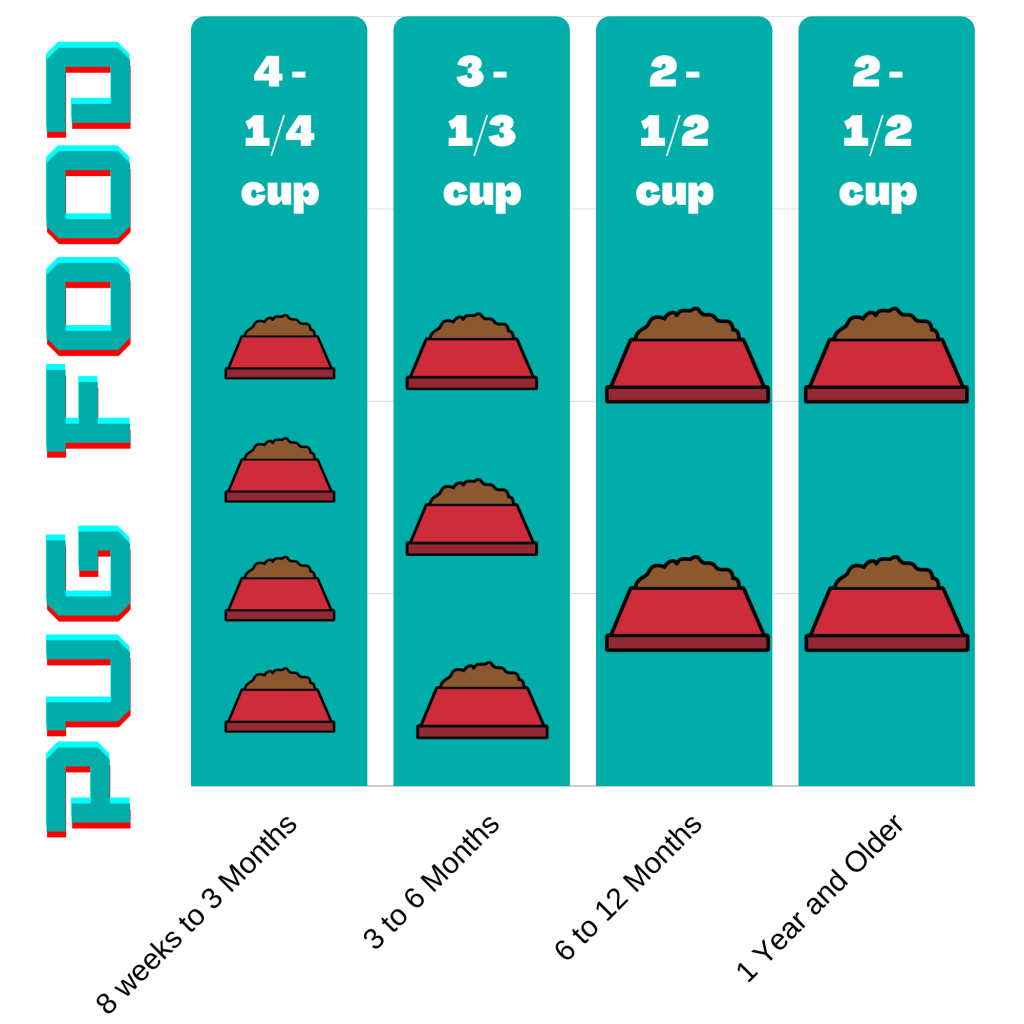
8 Weeks to 3 Months
When you bring your pug puppy home, plan on four times a day. Start with about 1/4 cup of high-quality puppy food. High-quality dry foods and wet foods have a lot of nutrition, so they won’t need as much.
If you’re feeding low-quality food, you could move toward ½ cup.
3 to 6 Months
At three months of age, reduce the feedings to three times per day.
If he had previously eaten 1/4 cup at each meal, feed him 1/3 cup at each meal, so he still gets 1 cup of food each day. Watch his waistline and keep him at a healthy weight. Often a Pug may want more, but it doesn’t mean he needs more. Pugs gain weight quickly. Obesity in pugs can lead to all kinds of health problems. These are easily avoided by keeping him at a healthy weight.
6 to 12 Months
Around six months old, feed your Pug twice per day. If he was eating a cup total per day, keep it that way. Instead of 1/3 cup at each meal, make it 1/2 cup at each meal. Ask your vet if you’re not sure about a healthy weight for your Pug. I always like to see a slight waistline as I look down on them.
12 Months and Older
When a Pug turns one year old, some people feed their Pugs once per day. I don’t recommend it. Most Pugs are chowhounds and like to eat often. Also, their stomachs are smaller than other dogs, so twice a day makes sense. It’s hard for them to digest a significant amount in one feeding.
When switching to adult dog food, introduce it slowly so he can digest it easier.
Your Pug should not be a square shape. If your Pug is a square or thick rectangle shape, he’s getting too much food.
If you decide to make the dog food yourself, you will need about half the amount of food. The reason is that these recipes have much more nutrition than other dog food.
But won’t he be even more hungry? No. Sure the fillers in commercial dog food will make him feel full very fast. But just like white rice, the being full feeling goes away quickly.

Conclusion
Getting what’s best for your pug dog can be complicated. I’ve simplified all of the essential parts of this article.
- How to read a dog food label?
- What’s in a product name?
- How much protein is in your pug dog food, and how important is it?
- How to figure out all of those ingredients?
- Why it’s important to understand:
- Guaranteed Analysis
- The Nutritional Adequacy Statement
- Complete and Balanced
- How much to feed your Pug dog
Buying the right dog food is one of the most important things you can do your him or her. It’s deceiving when you read words like “natural” and “formula.” Turn the bag around and understand what’s really in your Pug dog food. Understanding a dog food label will help you determine what is the best dog food for your Pug.

